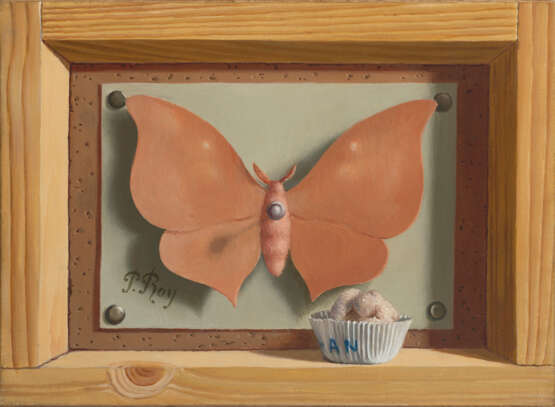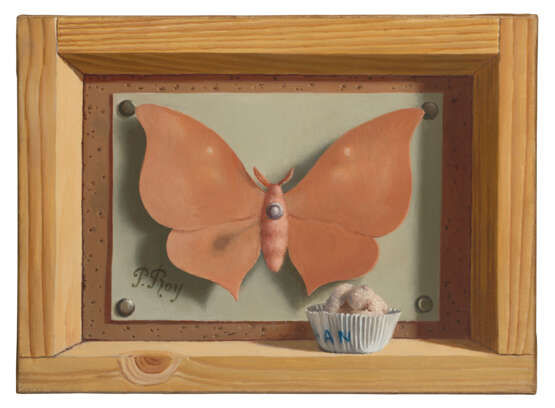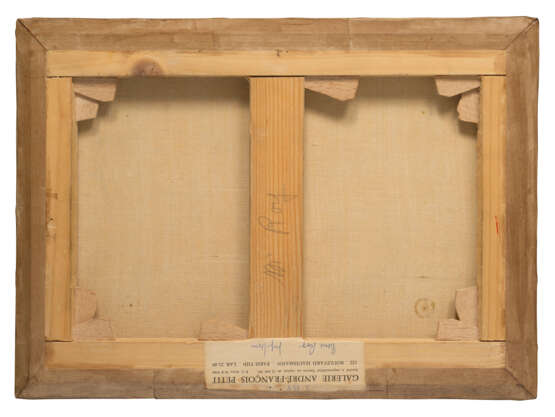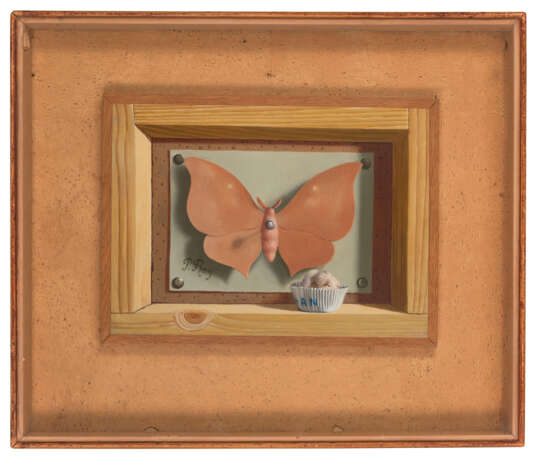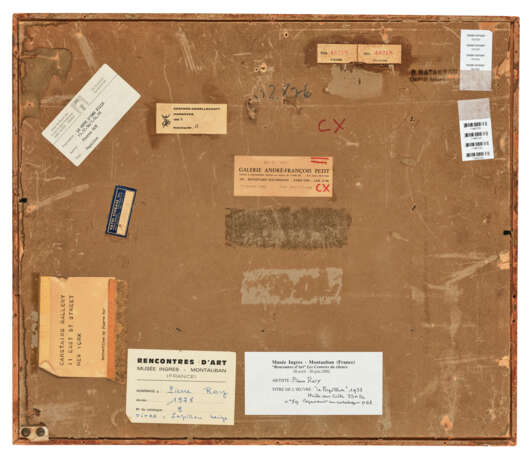ID 1302173
Lot 64 | Pierre Roy (1880-1950)
Estimate value
€ 30 000 – 50 000
Papillon
signé 'P. Roy' (en bas à gauche)
huile sur toile
24 x 32.8 cm.
Peint en 1933
signed ‘P. Roy’ (upper left)
oil on canvas
9 ½ x 12 7/8 in.
Painted in 1933
Provenance
Carstairs Gallery, New York (avant 1949 et jusqu'à au moins 1951).
Galerie André-François Petit, Paris (avant 1967).
Probablement acquis auprès de celle-ci en 1969.
Literature
Somogy, éd., Pierre Roy, Musée des Beaux-Arts, Nantes, cat. exp., 1994, p. 152, no. 53 (illustré en couleurs, p. 79).
Exhibited
New York, Carstairs Gallery, Pierre Roy, novembre-décembre 1949, no. 15 (titré 'Butterfly, No. 4').
Hanovre, Kestner-Gesellschaft, Pierre Roy, avril-juin 1967, no. 18.
Montauban, Musée Ingres, Hommage à Pierre Roy, avril-mai 1978, no. 8 (titré 'Papillon beige').
Nantes, Musée des Beaux-Arts, Le rêve d'une ville, Nantes et le surréalisme, décembre 1994-avril 1995, p. 152, no. 53 (illustré en couleurs, p. 79).
Montauban, Musée Ingres, Les Contrées du silence, avril-juin 2002, p. 68, no. 59 (illustré en couleurs).
Further Details
Précurseur de la peinture surréaliste, l’artiste nantais Pierre Roy est sans doute le plus mal connu de tous les artistes surréalistes. Peintre solitaire, non doctrinaire et sans motivations pour changer la réalité sociale, il ne se rattache au mouvement surréaliste que par sa peinture, étonnamment précoce. Pierre Roy se lance en effet dans la peinture dès 1905 et exposera ses œuvres à plusieurs reprises au Salon des Indépendants de Paris de 1907 à 1914. Il se rapproche ensuite des artistes surréalistes et expose entre autres aux côtés de Giorgio de Chirico ou de Max Ernst au cours des années 1920. Celui qui se lia d’amitié avec Guillaume Apollinaire et qui participa à la première exposition Surréaliste chez Pierre Loeb en 1925, ne fut cependant qu’un 'compagnon de route' du mouvement surréaliste et conserva toute sa vie sa nature indépendant.
L’œuvre de Pierre Roy s’articule entre des évocations d’événements qui ont marqués son enfance, passée sur les bords de la Loire et dans le pays de Retz et des associations aléatoires d’objets, fidèle aux idées surréalistes. Le présent Papillon, est ainsi une œuvre caractéristique de la production de Roy. Dans cette œuvre, l’artiste rassemble divers objets dans un cadre de bois, conférant à sa composition une aura particulière ainsi qu'un sentiment d’étrangeté que l’on peut rapprocher des intérieurs métaphysiques de Giorgio de Chirico, de certaines compositions de René Magritte ou de certains paysages de Salvador Dalí.Avec son cadre peint suggéré renvoi également au concept de la ‘boite surréaliste’ : ce concept artistique élaboré par Marcel Duchamp et Man Ray consiste en un assemblages hétéroclite d’objets tout faits ou fabriqués à la manière d'un cabinet de curiosités de voyage, d'un musée portatif. En effet, de par la place centrale du papillon au sein de la composition et le cadre peint, cette toile présente de prime abord une composition relativement classique, dans la tradition des cabinets de curiosité et surtout des boîtes entomologique. Cependant, bien que cette composition paraisse cohérente, les éléments picturaux ici associés, apparemment sans lien, interpellent. Comme souvent chez Pierre Roy, un élément (ici en bas à droite) vient perturber la cohérence et la lecture de l’œuvre, offrant ainsi un champ d’interprétation plus large à celui qui regarde l’œuvre.
Enfin, la présente œuvre de 1933 est aussi le fruit d’une longue tradition picturale faisant écho à certains détails de tableaux de primitifs flamands, tant par leur exécution très fine que par la disposition d’objets usuels. L’œuvre est les concepts auxquels elle fait appelle, est également à rapprocher d’œuvres d’artistes contemporains de Pierre Roy : que ce soit Man Ray avec son Hôtel Meublé de 1921,André Breton avec ses Boites de Coléopthères, Joseph Cornell ou encore Paul Duchein lui-même.
A precursor of surrealist painting, the artist from Nantes, Pierre Roy, is perhaps the least known of all surrealist artists. A solitary painter, non-doctrinaire, and uninterested in changing social reality, he only aligns with the Surrealist movement only through his remarkably precocious painting. Pierre Roy began painting in 1905 and exhibited his works several times at the Salon des Indépendants in Paris from 1907 to 1914. He later connected with Surrealist artists and exhibited alongside figures such as Giorgio de Chirico and Max Ernst during the 1920s. Despite his friendship with Guillaume Apollinaire and his participation in the first Surrealist exhibition at Pierre Loeb's gallery in 1925, Roy remained a "fellow traveler" of the Surrealist movement, maintaining his independent nature throughout his life.
Pierre Roy's work oscillates between evocations of events from his childhood, spent along the banks of the Loire and in the Pays de Retz, and random associations of objects, in keeping with Surrealist ideas. The present work, Papillon is a characteristic example of Roy's production. In this piece, the artist assembles various objects within a wooden frame, imparting a unique aura and a sense of strangeness reminiscent of Giorgio de Chirico's metaphysical interiors, some compositions by René Magritte, or certain landscapes by Salvador Dalí. The suggested painted frame also alludes to the concept of the 'Surrealist box': an artistic concept developed by Marcel Duchamp and Man Ray, consisting of eclectic assemblies of ready-made or custom-made objects in the manner of a travel curiosity cabinet or a portable museum. Featuring a centrally placed butterfly and a painted frame, this painting initially presents a relatively classical composition, reminiscent of curiosity cabinets and particularly entomological boxes. However, despite its seemingly coherent composition, the pictorial elements here, apparently unrelated, provoke curiosity. As often in Pierre Roy's work, an element (here in the bottom right) disrupts the coherence and reading of the piece, offering a broader field of interpretation to the viewer.
Finally, this work from 1933 also draws from a long pictorial tradition, echoing details of early Flemish paintings, both in their very fine execution and in the arrangement of everyday objects. The work and its underlying concepts can also be associated with those of contemporary artists such as Man Ray with his Hôtel Meublé from 1921, André Breton with his Boîtes de Coléopthères, Joseph Cornell, and even Paul Duchein.
| Artist: | Pierre Roy (1880 - 1950) |
|---|---|
| Applied technique: | Oil on canvas |
| Auction house category: | Paintings, Watercolors, Drawings, Paintings |
| Artist: | Pierre Roy (1880 - 1950) |
|---|---|
| Applied technique: | Oil on canvas |
| Auction house category: | Paintings, Watercolors, Drawings, Paintings |
| Address of auction |
CHRISTIE'S 8 King Street, St. James's SW1Y 6QT London United Kingdom | |
|---|---|---|
| Preview |
| |
| Phone | +44 (0)20 7839 9060 | |
| Buyer Premium | see on Website | |
| Conditions of purchase | Conditions of purchase |
